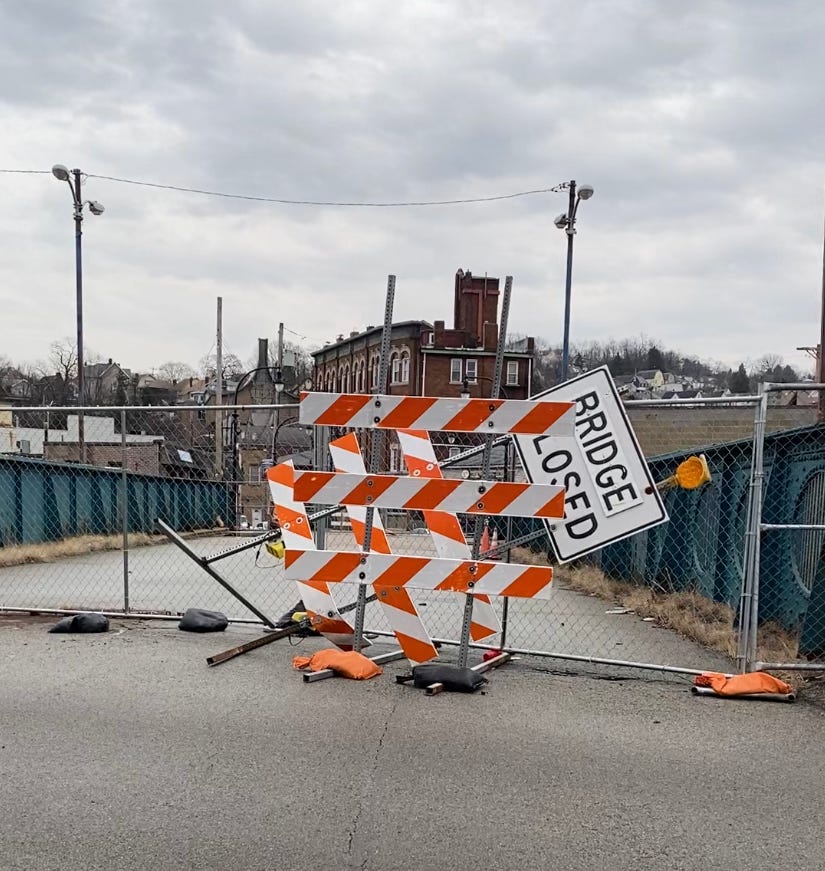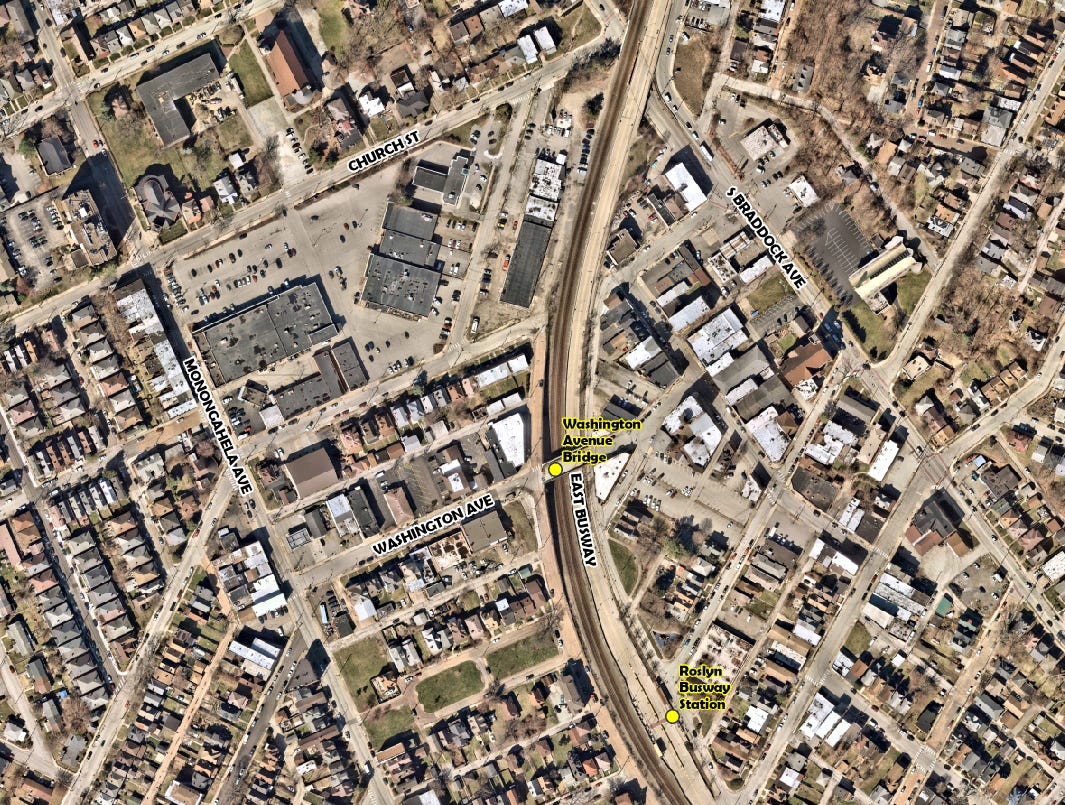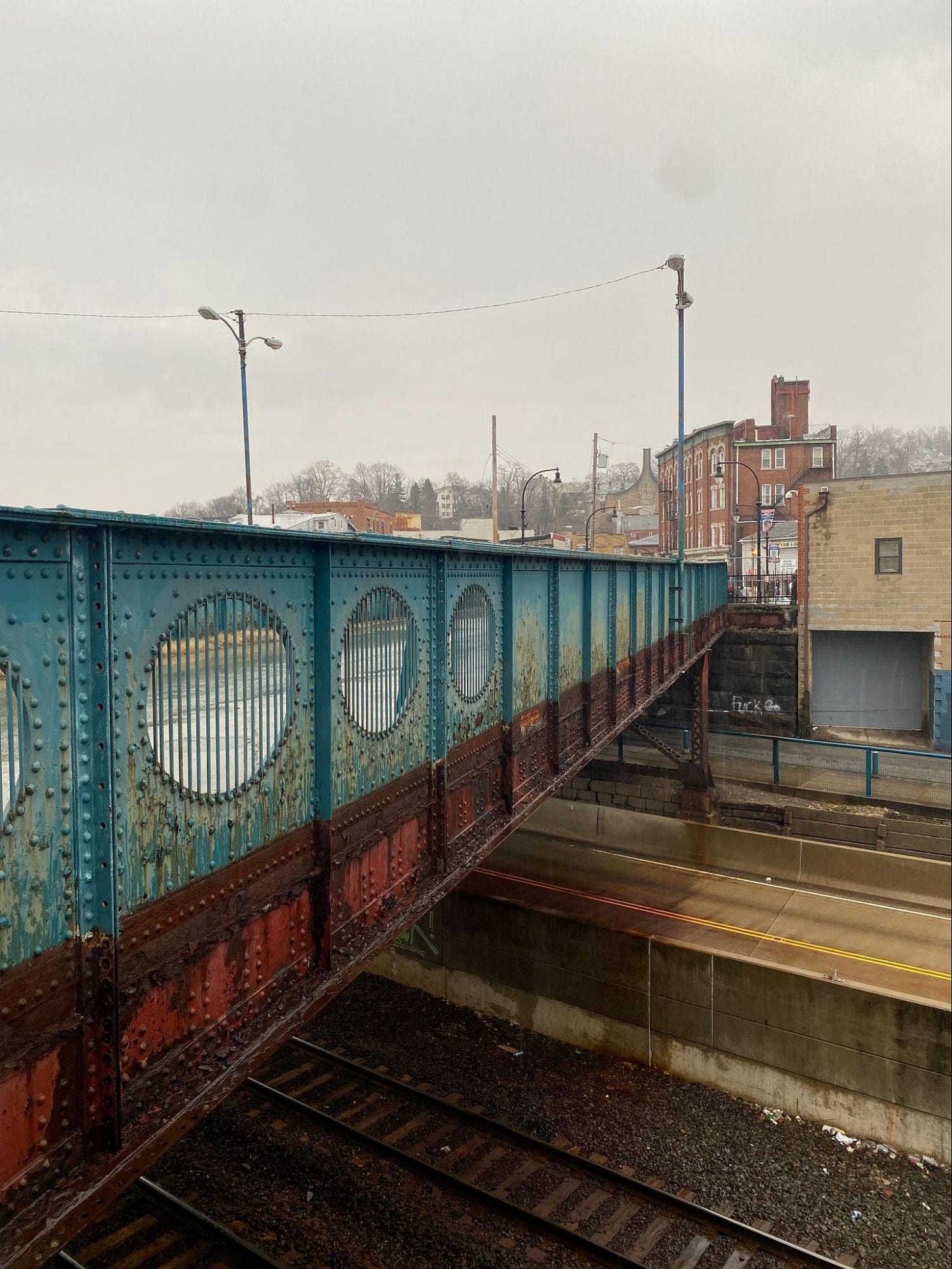A Bridge in Winter
By Dani Lamorte
When Bill Price, a member of the Swissvale borough council, told me he was concerned about the chemicals Norfolk Southern Railroad might be transporting through our town, neither of us wanted that concern to be prescient. A few weeks later, the derailment of an NFS train one hour east of Swissvale, in East Palestine, led to the release of vinyl chloride and the evacuation of a small town. Price and I didn't meet to discuss railway safety, though. We were talking about what goes over the rails: the Washington Street Bridge.
In July 2022, Swissvale officials closed the Washington Street Bridge, citing concerns about its structural stability. The closure came less than seven months after the collapse of the Fern Hollow Bridge in Pittsburgh's Frick Park, only 1.5 miles away. Constructed in 1907, the Washington Street Bridge spans the Norfolk Southern Pennsylvania rail line which bisects the borough of Swissvale on a diagonal axis from Northwest to Southeast. Swissvale is a modest borough of approximately 8600, located on the eastern edge of the city of Pittsburgh, Pennsylvania. Since the closure of the bridge, borough officials and railroad executives have discussed repairing the bridge but no agreement has been reached. Ownership of the bridge is split: the railroad company owns (and is responsible for) the structure that upholds the roadway and pedestrian walkways; the borough maintains the driving and walking surfaces. Not long after the bridge was closed to all traffic, the pedestrian walkway along its north side was reopened. Many of us who still walk across the bridge doubt its safety. We hope we're lucky each time we take a step.
The Washington Street Bridge is small, only 122 feet in length, but the impact of its closure is significant. The next railroad crossing to the south is three-quarters of a mile away — a considerable distance for pedestrians and motorists alike. To the north, the nearest crossing is 900 feet away at the Braddock Avenue "subway," an underpass on the urban artery. Dana Och, a long-time Swissvale resident, remarks that pedestrian crossing signals along Braddock Avenue were already too short, making crossings hazardous for people with mobility issues. Since the bridge closure, local and commuter traffic vie for space in the underpass. Och suggests the green lights along Braddock Avenue may be longer than before, to accommodate for the increased flow. She assesses the situation to be dangerous and untenable for residents who travel the area on foot. Circumventing the closed bridge from my own home routinely adds a quarter mile of travel, by car or foot. The bridge closure is a functional disconnect between two halves of our borough and an ongoing safety concern. Moreover, the bridge's history suggests that this 'temporary' closure is part of an ongoing collapse.
Construction of the Washington Street Bridge was ordered in a 1905 "Subway Ordinance." The ordinance, named for the Braddock Avenue underpass, addressed the "deadly" situation pedestrians and motorists faced when trying to cross the railroad tracks that had been laid a half-century prior. As Bill Price and many others see it, the railroad and Swissvale had a "symbiotic" relationship in the turn-of-the-century. The railroad brought money, in the form of jobs at the local Kopp Glass and Union Switch & Signal plants. Swissvale residents brought labor to those companies. Kopp held a patent on the red Selenium glass preferred for railroad traffic signals. Union Switch & Signal, founded by George Westinghouse, manufactured the airbrakes which allowed trains to stop safely. In a manner of speaking, Swissvale manufactured railway safety for the nation and the bridge returned safety back to borough residents.
The Subway Ordinance addressed some, but not all, of the unevenness in the borough-railroad relationship. In 1888, Swissvale's neighboring village — Edgewood — incorporated and annexed much of the land occupied by Union Switch & Signal. According to Swissvale Diamond Jubilee, a booklet published to celebrate Swissvale's 75th anniversary, the annexation meant that the lion's share of tax paid by US&S went to Edgewood rather than Swissvale. Meanwhile, Swissvale was left with the overburdened roads and hazardous railroad crossings that connected US&S to the rest of the country. The State Supreme Court heard Swissvale's complaint against Edgewood, but sided with the latter. The former site of US&S is now a bustling shopping center, and remains within Edgewood's borders.
The mid-and late 20th century brought Swissvale all the rustbelt clichés of urban downturn. The bridge stood, even as industry went elsewhere — to other states, other countries. Unions faltered and the bridge stood. The population declined and the bridge stood. It stood, by all accounts, until it dramatically displayed its age in 1974. That year, one of the pedestrian walkways that line the north and south edges of the structure collapsed unexpectedly. The walkway was reinforced with a steel plate and reopened. One year later, the opposite walkway collapsed during resurfacing by the borough. To date, the bridge has only one functional walkway. After the '74-'75 walkway collapses, the bridge remained open to auto traffic, though local public transit buses rerouted out of caution. In August 1976, the Pennsylvania Utility Commission ordered Conrail, then owner of the railroad below the bridge, to make repairs. Protestors gathered on the bridge in March 1977 after Conrail missed its deadline for said repairs by six months. The railroad corporation had spent those months trying to rebuild things in court instead.
In court, Conrail argued that it had no real jurisdiction over the bridges which crossed its lines, and thus no responsibility to repair those bridges. By 1979, Conrail made repairs to the bridge but the rapport between the borough and railroad was unsalvageable. In 1999, Swissvale's government pursued Conrail's successor, Norfolk Southern Railroad, in court again. NFS made a series of repairs in 2001, but borough leaders were dissatisfied with the quality of the work. It was clear to residents that the railroad wasn't holding up its end of things, quite literally. Warren Cecconi, borough Manager at the time, called for the bridge to be replaced. Internally, NFS had also recognized that the bridge might need to be replaced. Their concern wasn't the bridge's stability, tough. They were concerned about its height.
By 1984, double-decker trains were becoming an industry standard, according to an NFS representative I spoke with, as the taller trains allowed companies to ship more cargo at once. Old infrastructure like the Washington Street Bridge, which doesn't have the vertical clearance to let double-decker trains pass, stood in the way of this vertical growth. Over time, NFS considered its options for each site which blocked progress. Around 2003, the railroad company investigated replacing the Washington Street Bridge, according to NFS engineer Todd Willoughby. Unfortunately for Swissvale, there was a cheaper option: lowering the tracks. Ever since that determination was made, the company has pursued the political and ecological clearances needed to sink the railroad tracks into the ground; lowering the floor instead of raising the roof. Now, the Washington Street Bridge hangs overhead, grayed out.
I warn newcomers to Pittsburgh: there will be six weeks of winter when the gray sky matches the gray pavement below. We won't see the sun. Many of us won't feel quite alive. Things are grayed out. 'Grayed out' can also refer to something, perhaps a piece of infrastructure or circuitry, which is in place but nonfunctional, offline. graying out, like winter, can be a time of recharge or repair. From a certain angle, the bridge closure has reinvigorated important conversations about the relationship between our borough and the corporations which do business within or across our borders. The bridge went offline and now we all have to talk about it, about the railroad, about the future of our borough. For all the conversation, though, I note how little power Swissvale has to force corporations to do right by us. It's unclear if necessary changes to industrial policy and regulation will come, even after a disastrous derailment in the state next door. How can the story of a short bridge in a small place be heard over the drone of corporate lobbyists and PR spin? (Last year, NFS spent nearly $2,000,000 on lobbyists, according to data from OpenSecrets.) Bill Price complains that the relationship between Swissvale and the railroad is no longer symbiotic. Pointing at the loss of local jobs, he says the trains don't bring us anything anymore. Unfortunately, the train brings us plenty. They bring us noise and pollution, to start. If East Palestine is any indicator, they may bring us things far worse.
Dani Lamorte is a Pittsburgh-based artist. His first book of essays is forthcoming from the University Press of Kentucky. More at: www.danilamorte.com.
Weathered is a recipient of a generous grant from the Graham Foundation for Advanced Studies in the Fine Arts. Head to the Madlener House to see their new exhibition, “A different kind of tender and practice of overhealing,” works by Katherine Simóne Reynolds. Visit grahamfoundation.org to learn more.




